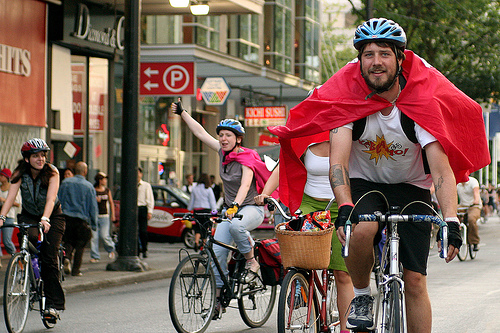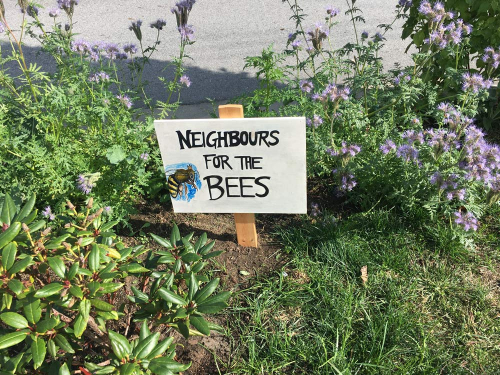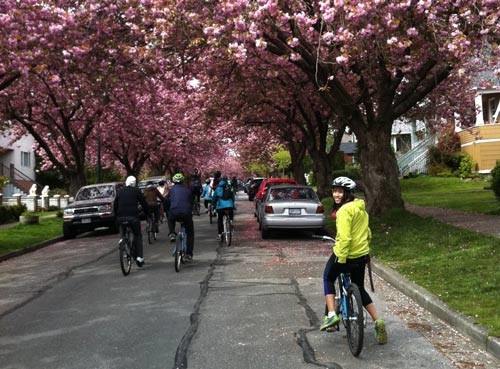How the oil crisis will change the face of Fraser Highway
Increasingly, the news in the blogs I read has focused on climate change, biofuels and alternative energy for fueling transportation… and with good reason. We’re faced with a crisis, and we all know that. Many of the solutions already exist, in the past before depedence on oil became the norm for most transportation, and gave us solid plastic, plastic bags, chemical fertilizers, fat-free ice cream (propylene glycol, anyone?), and the American Dream: a big house on a big lot in suburbia. Well, Canadians have made that dream as much of a reality as our neighbours to the south, and in greater Vancouver, the hidden evil of it is present in perhaps no stronger a form than in the suburbs of Surrey and Langley.
A highway took over for an Interurban Railway that operated for roughly the first half of last century. Old Cloverdale found itself in the middle of increasing development, but not increasing density. And Fraser Highway, which begins near the King George SkyTrain station and ends at the foot of Abbotsford, got itself an ongoing facelift beginning about three years ago when expansions started working their way, measure by measure. Through Surrey, it is now the wide, free road with low commercial spaces dotted down either side, reminiscient of James Howard Kunstler’s image of an American car town strip mall, except this strip only has one fast food joint and a couple Tim Horton’s. Wait, make that three fast food joints. Four if you count Taco Del Mar. It doesn’t need fast food, chain restaurants, a Wal-Mart, or anything particularly big, per the typical American strip mall, to be a driver’s den. It’s already full of services for the car culture: car services. You name it, you got it: car dealerships, car washes, auto parts vendors, car tune-up services, gas stations, drive-thru restaurants. In fact, when I realised the number of these types of businesses, I decided to pin them in Google Maps… and didn’t even get all of them because some are just too obscure. This is, in all honesty, the most car-centric route I know of in Metro Vancouver. Take a look. (NOTE: In my RSS the map isn’t appearing properly, so please come to the entry in your browser if that’s the case.)
Now add all those tire shops, car dealerships, mini-malls, former car dealerships, and used car lots together and what do you get? A very, very long parking lot. Gee I sure wish I had a photo. They’re still in the process of widening this road, too, all the way to the park. If there weren’t a park there, I’m sure they’d continue. And yet, here we are bombarded with the news about the decline of oil, the urgent need to launch sustainable new energy sources, and the rising costs of transportation and food. So what are we doing widening a road and trying to widen a highway and twin a bridge?
What will happen to this suburb, and specifically, how will this particular car-centric route respond and adapt to change?
I see the future bringing an overhaul in transportation and urban planning in this region. As a result of this I see a shift in Fraser Highway’s economy: car-serving businesses will either have to adapt to different technology (e.g. serving electric vehicles) or die. If we see a significant switch from the personal vehicle to public transportation — great transit has to be in place first — I imagine the number of auto services will dwindle significantly. I would hope to see different rezoning, even right now, that eliminates most single-storey buildings and replaces them with mixed-use, 4 to 6-storey apartments that incorporate attractive street-level commercial spaces… with underground parking wherever possible. There are plenty of buildings that I see fit to replace, specifically from about the intersection of 88th Avenue & Fraser Hwy all the way to 162nd St. If this city is so concerned with building more housing, why not think about using existing spaces to move upward, revitalising the streetscape and creating a denser, more walkable community? We’ve got a gorgeous Fleetwood library hidden behind this mish-mash of ugly old buildings.
Paul was telling me that taller buildings on either side of the road — or taller trees, for that matter (even better!) — make wide roads look narrower because of their height. I compared Mount Seymour Parkway in North Vancouver, to Fraser Highway. Both are four lanes with a narrow boulevard, and yet Mt. Seymour Pkwy doesn’t have that spread-out look. Why? It’s lined with very tall trees on either side from its foot at Beachview Drive in the Cove (those bottom three blocks are two lanes) all the way to where it engages with Highway 1 and the road leading up to Capilano College (I think that’s called Purcell Way). It barely sees a break. And you know what? I’ve never second-guessed its beauty. Fraser Highway between 152nd St and 164th? Well, I think my first reaction to it about three years ago was, “I’m glad I don’t live here,” and all I could remember was the Nissan dealership. At its worst, the only trees are the ones that just got planted after the old-growth ones were ripped up. And that’s the problem: they tear down the old ones and plant little ones in their stead. I have my doubts that they did that in North Vancouver. But the difference between the two really illustrated how Paul’s statement was true. I mean, even a 3-lane Howe Street in Downtown Vancouver doesn’t seem like it’s 3 lanes because it’s surrounded by highrises. I’m not advocating highrises here, but some well thought-out, beautifully-designed, quality architecture of more than one storey would really help bring the focus away from this hot, hideous road.
Paul made another point. The boulevard gives people an excuse to drive faster (if not actually raising the speed limit). So not only does it make the whole road wider, it also just gives drivers more free reign and possibly makes it more dangerous. Stephen Rees is always saying how we must slow cars down and give transit priority. (The government counters back on that one insisting we must widen the road before giving the buses dedicated lanes.)
So in the future… do we dig up half the lanes, turn them back into treed, grassy strips and bring the shops right up to the sidewalk? Do we move up rather than out? Do we rip up the parking lots, add car-sharing networks and bring in light rail transit? Imagine attractive, graffiti-free street furniture for folks waiting for the light rail tram, and extra little parks in place of development notices. This route will change, and it will be a needed and necessary change that will, I think, ultimately make it very attractive. Can you imagine?



